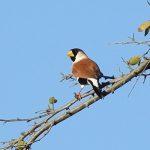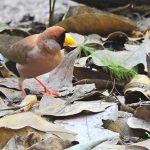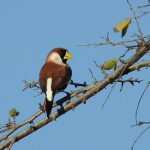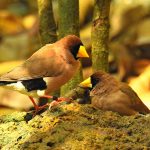MASKED FINCH
Meet the Masked Finch
| Common Name | Masked Finch |
|---|---|
| Scientific Name | Poephila personata |
| Family | Estrildidae |
| Status | Least Concern |
| Range | Northern Australia |
Appearance
Small (12–13.5 cm), with a memorable black facial mask, bright yellow-orange bill and lively orange legs. Males and females are equally dapper—no discrimination in style here!
Habitat
Prefers northern Australia—think tropical savannas, grasslands, and open woodlands. Crucially, they insist on living near water, making their homes in places where life can be both lush and harsh.
Social Behaviour and Diet
- Flocks of Fancy: Highly sociable, Masked Finches gather in bustling flocks. This communal life offers protection and collaborative foraging, transforming survival into a team sport.
- Favourite Foods: Their staple is grass seeds, but after the rains, they aren’t shy to snatch up insects—especially when feeding protein-hungry chicks.
Nature’s Adaptation Artists
Masked Finches are true survivors, finely tuned to the pulse of the Australian climate.
How Do They Cope with a Changing Climate?
| Adaptation | Superpower | Survival Benefit |
|---|---|---|
| Mobile Flocks | Move when water dries up | Find new resources, avoid starvation |
| Opportunistic Breeding | Breed after rain | Maximise chick survival in good times |
| Flexible Diet | Eat seeds and insects | Meet nutritional needs year-round |
| Adaptive Foraging | Feed at dawn/dusk in summer | Avoid heat and water loss |
| Shady Roosting & Group Hugs | Nest communally, rest in shade | Save energy and stay safe |
| Social Intelligence | Information-sharing in the flock | Find water, avoid predators |
- Water Wise: Rather than sticking to one spot, Masked Finches shift locations as water becomes scarce—a mobile strategy, adjusting range sometimes by several kilometres.
- Heat Hackers: Forage in the cool of morning and evening, then relax in shade through midday heat. They even conserve body heat by roosting in tight groups at night.
- Breeding on Cue: Wet season rains trigger breeding—after all, you want plenty of food to raise your chicks! But they’ll also rush into nest-building after unseasonal downpours, demonstrating impressive flexibility.
Resilience… with Limits
While their adaptability is impressive, climate change poses some tough challenges:
- Long, Unrelenting Drought: Can deplete water sources beyond their range to relocate.
- More Heatwaves: May affect breeding success and survival rates.
- Habitat Changes: If savannas shift to shrubland or are cleared, Masked Finches could lose their homes.
These little birds serve as ecosystem indicators—like canaries in a (savanna) coalmine—helping researchers understand broader environmental changes in northern Australia.
The Masked Finch is living proof of nature’s ingenious responses to a changing world—and does it all with a feathered flourish.
References
- Birdlife Australia – Masked Finch Profile
- Australian Museum: Masked Finch
- Peer-reviewed studies on finch adaptation and climate science






